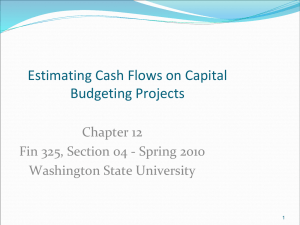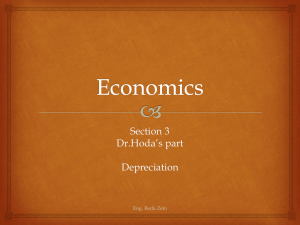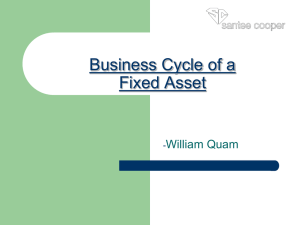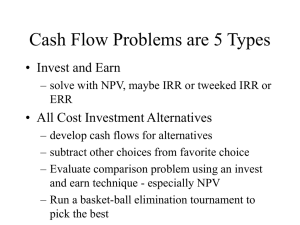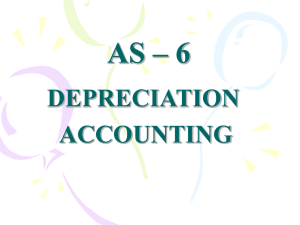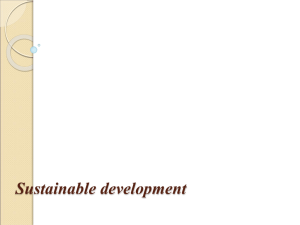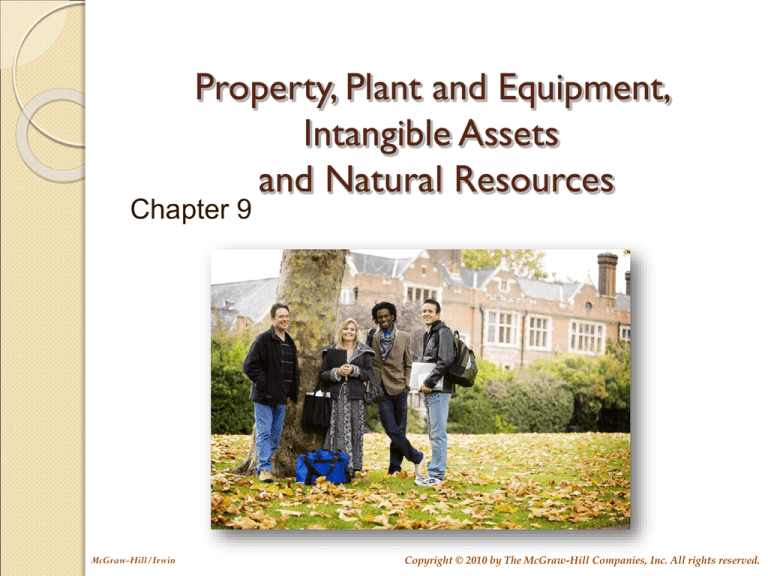
Property, Plant and Equipment,
Intangible Assets
and Natural Resources
Chapter 9
McGraw-Hill/Irwin
Copyright © 2010 by The McGraw-Hill Companies, Inc. All rights reserved.
Property, Plant and Equipment
Represent tangible assets that are held for:
Use in the production or supply of
goods or services
Rental to others, or
Administrative purposes
Expected to be used in multiple periods
Examples:
Land, Buildings and Office Equipment
9-2
Intangible Assets
Identifiable non-monetary assets without
physical substance
that is controlled by the entity and
has future economic benefits
Examples:
Patents, Copyrights, Trademarks,
Franchises and Goodwill
9-3
Natural Resources
Refer to mines, oil fields, standing timber
and similar assets that are physically
consumed and converted into inventory
9-4
Accountable Events in the
Lives of PPE Assets
Acquisition.
Allocation of the acquisition
cost to expense over the
asset’s useful life (depreciation).
Sale or disposal.
9-5
Acquisition of PPE Assets
Cost
=
Asset
price
+
Reasonable and
necessary costs . . .
. . . for getting
the asset to the
desired location.
. . . for getting
the asset ready
for use.
9-6
Special Considerations
Land
Land
Improvements
Cost includes real estate
commissions, escrow
fees, legal fees, clearing
and grading the property.
Improvements to land
such as driveways,
fences, and landscaping
are recorded separately.
9-7
Special Considerations
Buildings
Repairs made prior to the
building being put in use
are considered part of the
building’s cost.
Equipment
Related interest,
insurance, and property
taxes are treated as
expenses of the current
period.
9-8
Special Considerations
Allocation of a Lump-Sum Purchase
The total cost
must be
allocated to
separate
accounts for
each asset.
The allocation
is based on
the relative
Fair Market
Value of each
asset
purchased.
9-9
Capital Expenditures and Revenue
Expenditures
Capital
Expenditure
Revenue
Expenditure
Any material expenditure
that will benefit several
accounting periods.
Expenditure for
ordinary repairs
and maintenance.
To capitalize an expenditure
means to charge it to an
asset account.
To expense an expenditure
means to charge it to an
expense account.
9-10
Measurement after Acquisition
Cost
Model
Fair
Value
Book value
= Cost
– Accumulated depreciation
– Accumulated impairment losses
Book value
= Revalued amount
– Subsequent accumulated
depreciation
– Subsequent accumulated
impairment losses
9-11
Depreciation
The allocation of the cost of a PPE asset to
expense in the periods in which services are
received from the asset.
Balance Sheet
Cost of
PPE
assets
Assets:
Property, plant
and equipment
Income Statement
as the services are
received
Revenues:
Expenses:
Depreciation
9-12
Depreciation
Accumulated Depreciation
Contra-asset
Represents the portion of an asset’s
cost that has already been allocated to
expense.
Causes of Depreciation
Physical deterioration
Obsolescence
9-13
Straight-Line Depreciation
Depreciation
=
Expense per Year
Cost - Residual Value
Years of Useful Life
9-14
Straight-Line Method
(Cost Model)
On 2 January, S&G Wholesale Supermarket buys a
new delivery truck. The truck cost $340,000, has
an estimated residual value of $40,000, and an
estimated useful life of 5 years.
Compute annual depreciation using the straight-line
method.
Cost – Residual Value
$ 340,000 – $ 40,000
=
Years of Useful Life
5
= $
60,000 per year
9-15
Straight-Line Method
(Cost Model)
S&G will record $60,000 depreciation each year for
five years. Total depreciation over the estimated
useful life of the equipment is:
Year
First
Second
Third
Fourth
Fifth
Depreciation
Expense
(debit)
$
$
60,000
60,000
60,000
60,000
60,000
300,000
Accumulated
Depreciation
(credit)
$
$
60,000
60,000
60,000
60,000
60,000
300,000
Accumulated
Depreciation
Balance
$
60,000
120,000
180,000
240,000
300,000
Undepreciated
Balance
(book value)
$
340,000
280,000
220,000
160,000
100,000
40,000
Salvage Value
9-16
Straight-Line Method
(Revaluation Model)
Assume the delivery truck is revalued with a fair
value of $243,000 (remain the same until end of
year 5) and a residual value of $42,000 at the
end of Year 2. Compute annual depreciation using
the straight-line method before adjusting for
revaluation.
Cost – Residual Value
$ 340,000 – $ 40,000
=
Years of Useful Life
5
= $
60,000 per year
9-17
Straight-Line Method
(Revaluation Model)
Total depreciation over the estimated useful life of the
equipment is:
Year
First
Second
Before
(debit)
$
60,000
60,000
After
Third*
Fourth
Fifth
67,000
67,000
67,000
$ 321,000
* (243,000 - 42,000) / 3
(credit)
$
60,000
60,000
(23,000)
67,000
67,000
67,000
Balance
$
60,000
(book value)
$
340,000
280,000
120,000
97,000
164,000
231,000
298,000
220,000
243,000
176,000
109,000
42,000
Salvage Value
9-18
Depreciation for Fractional
Periods
When an asset is acquired during the year,
depreciation in the year of acquisition must
be prorated.
Half-Year Convention
In the year of
acquisition, record six
months of depreciation.
½
9-19
Half-Year Convention
Using the half-year convention, calculate the
straight-line depreciation on 31 December,
2010, for equipment purchased in 2010. The
equipment cost $75,000, has a useful life of 10
years and an estimated residual value of
$5,000.
Depreciation =
=
($75,000 - $5,000) ÷ 10
$7,000 for a full year
Depreciation =
$7,000 × 1/2 = $3,500
9-20
Declining-Balance Method
Depreciation in the early years of an asset’s
estimated useful life is higher than in later years.
Accelerated
Depreciation
Remaining
=
× Depreciation
Expense
Book Value
Rate
The double-declining balance depreciation
rate is 200% of the straight-line depreciation
rate of (1÷Useful Life).
9-21
Declining-Balance Method
(Cost Model)
On 2 January, S&G buys a new delivery truck
paying $340,000 cash. The truck has an
estimated residual value of $40,000 and an
estimated useful life of 5 years.
Compute depreciation for the first year using
the double-declining balance method.
First Year
Expense
=
=
=
=
Remaining
×
Book Value
$
340,000 ×
$
340,000 ×
$
136,000
Accelerated
Depreciation Rate
2 × 1/5
40%
9-22
Declining-Balance Method
(Cost Model)
Total depreciation over the estimated useful life of an
Compute depreciation for the rest of the
asset is the same using either the straight-line
estimated usefulmethod.
life.
methodtruck’s
or the declining-balance
Year
Computation
First
$ 340,000 × 40%
Second
204,000 × 40%
Third
122,400 × 40%
Fourth
73,440 × 40%
Fifth
Plug year # 5
Total Depreciation
Depr.
Accumulated
Expense Depreciation Book Value
$ 136,000 $ 136,000 $ 204,000
81,600
217,600
122,400
48,960
266,560
73,440
29,376
295,936
44,064
4,064
300,000
40,000
$ 300,000
9-23
Declining-Balance Method
(Revaluation Model)
Assume the delivery truck is revalued with a fair
value of $131,400 (remain the same until end of
year 5) and a residual value of $43,000 at the
end of Year 2. Compute depreciation for the first
year using the double-declining balance method.
before adjusting for revaluation.
First Year
Expense
=
=
=
=
Remaining
×
Book Value
$
340,000 ×
$
340,000 ×
$
136,000
Accelerated
Depreciation Rate
2 × 1/5
40%
9-24
Declining-Balance Method
(Revaluation Model)
Compute
depreciation
forestimated
the restuseful
of the
Total depreciation
over the
of an asset
is: life.
truck’slife
estimated
useful
Year
Computation
First
$ 340,000 ×
40%
Second
Before 204,000 ×
40%
After
340,000 - 131,400
Third
131,400 ×
40%
Fourth
78,840 ×
40%
Fifth
Plug year # 5
Total Depreciation
Depr.
Accumulated
Expense
Depreciation Book Value
$ 136,000 $ 136,000 $ 204,000
81,600
52,560
31,536
4,304
$ 306,000
217,600
208,600
261,160
292,696
297,000
122,400
131,400
78,840
47,304
43,000
9-25
Financial Statement Disclosures
Estimates of Useful Life and Residual Value
• May differ from company to
company.
• The reasonableness of
management’s estimates is
evaluated by external auditors.
Principle of Consistency
• Companies should avoid switching
depreciation methods from period
to period.
9-26
Revising Depreciation Rates
Predicted
salvage value
Predicted
useful life
So depreciation
is an estimate.
Over the life of an asset, new
information may come to light that
indicates the original estimates need to
be revised.
9-27
Revising Depreciation Rates
On 1 January, 2007, equipment was
purchased that cost $30,000, has a useful
life of 10 years and no salvage value.
During 2010, the useful life was revised to
8 years total (5 years remaining).
Calculate depreciation expense for the
year ended 31December, 2010, using the
straight-line method.
9-28
Revising Depreciation Rates
When our estimates change,
depreciation is:
Book value at
date of change
–
Salvage value at
date of change
Remaining useful life at date of change
Asset cost
Accumulated depreciation, 31/12/2009
($3,000 per year × 3 years)
Remaining book value
Divide by remaining life
Revised annual depreciation
$ 30,000
9,000
$ 21,000
÷5
$ 4,200
9-29
Impairment of PPE Assets
If the cost of an asset
cannot be recovered
through future use or
sale, the asset should
be written down to its
net realizable value.
9-30
Disposal of PPE Assets (Cost Model)
Update depreciation
to the date of disposal.
Journalize disposal by:
Recording cash
received (debit).
Removing accumulated
depreciation (debit).
Removing accumulated
impairment loss (debit).
Recording a
gain (credit)
or loss (debit).
Removing the
asset cost (credit).
9-31
Disposal of PPE Assets
(cost Model)
If Cash > BV, record a gain (credit).
If Cash < BV, record a loss (debit).
If Cash = BV, no gain or loss.
Recording cash
received (debit).
Removing accumulated
depreciation (debit).
Removing accumulated
impairment loss (debit).
Recording a
gain (credit)
or loss (debit).
Removing the
asset cost (credit).
9-32
Disposal of PPE Assets (Cost Model)
Assume that a machine costing $10,000,
had accumulated depreciation of $8,000,
accumulated impairment loss of $0 and
book value of $2,000 (10,000 - $8,000) at
the time it was sold for $3,000 cash.
Determine the gain or loss on sale of this
machine.
Cost of machine
Accumulated depreciation
Book value at time of sale
Cash received
Gain on sale of machine
$ 10,000
(8,000)
2,000
3,000
$ 1,000
9-33
Disposal of PPE Assets (Cost Model)
Assume that a machine costing $10,000,
had accumulated depreciation of $8,000,
accumulated impairment loss of $0 and
book value of $2,000 (10,000 - $8,000) at
the time it was sold for $3,000 cash.
Determine the gain or loss on sale of this
machine.
Description
Cash
Accumulated Depreciation: Machinery
Gain on Disposal of PPE Assets
Machinery
Debit
Credit
3,000
8,000
1,000
10,000
9-34
Trading in Used Assets
for New Ones (Cost Model)
Assume that Essex Company exchanges a
used earthmover and $350,000 cash for a
new earthmoving machine. The old machine
originally cost $400,000, had up-to-date
accumulated depreciation of $300,000,
accumulated impairment loss of $0 and a fair
value of $40,000.
+ $350,000
9-35
Trading in Used Assets
for New Ones (Cost Model)
Cost of equipment
Accumulated impairment loss
Accumulated derpreciation: Equipment
$ 400,000
0
300,000
Book value of equipment
Fair market value of equipment
Loss on disposal of PPE assets
$ 100,000
40,000
$ 60,000
Description
Equipment (New earthmover)
Accumulated depreciation: Equipment
Loss on Disposal of PPE Assets
Equipment (Old earthmover)
Cash
Debit
Credit
390,000
300,000
60,000
400,000
350,000
9-36
Intangible Assets
Identifiable non-monetary
assets without
physical substance.
Often provide
exclusive rights
or privileges.
Characteristics
Useful life is
often difficult
to determine.
Usually acquired
for operational
use.
9-37
Intangible Assets
Initially
recognized at
current cash
equivalent cost,
including
purchase price,
legal fees, and
filing fees.
Patents
Copyrights
Leaseholds
Leasehold
Improvements
Goodwill
Trademarks and
Trade Names
9-38
Measurement after Recognition
•
Choose cost model or revaluation model.
Cost Model:
Cost
– Accumulated amortization
– Accumulated impairment losses
Revaluation Model:
Fair value at date of revaluation
– Subsequent accumulated amortization
– Subsequent accumulated impairment losses
•
Must use cost model where there is no active
market for the intangible asset.
9-39
Amortization
•
Amortization is the systematic write-off to
expense of the cost of intangible assets
over their useful life or legal life, whichever
is shorter.
•
Use the straight-line method to amortize
most intangible assets.
Date
Description
Amortization Expense
Intangible Asset
Debit
Credit
$$$$$
$$$$$
9-40
Goodwill
Occurs when one
company buys
another company.
Only purchased
goodwill is an
intangible asset.
The amount by which the
purchase price exceeds the fair
market value of net assets acquired.
Goodwill is NOT amortized. It is tested
annually to determine if there has been
an impairment loss.
9-41
Patents
Exclusive right granted
by the government to sell or
manufacture an invention.
Cost is purchase
price plus legal
cost to defend.
Amortize cost
over the shorter of
useful life or 20 years.
9-42
Trademarks and Trade Names
A symbol, design, or logo
associated with a business.
Internally
developed
trademarks
have no
recorded
asset cost.
Purchased
trademarks
are recorded
at cost, and
amortized over
shorter of legal
or economic life.
9-43
Franchises
Legally protected right to sell products
or provide services purchased by
franchisee from franchisor.
Purchase price is intangible asset
which is amortized over the shorter
of the protected right or useful life.
9-44
Copyrights
Exclusive right granted by the
government to protect artistic or
intellectual properties.
Legal life is
life of creator
plus 50 years.
Amortize cost
over period
benefited.
9-45
Research and Development Costs
Expenditure on research or on the
research phase of an internal project
are expensed when it is incurred .
All of these Research
costs will really reduce
our profit this year!
9-46
Research and Development Costs
Expenditure on development or on
the development phase of an
internal project are capitalized if and
only if all the specific recognition
criteria are met.
Development costs satisfying
specific recognition criteria can
be capitalized
9-47
Natural Resources
Total cost,
including
exploration and
development,
is charged to
depletion expense
over periods
benefited.
Extracted from
the natural
environment
and reported
at cost less
accumulated
depletion.
Examples: oil, coal, gold
9-48
Depletion of Natural Resources
Depletion is calculated using the
units-of-production method.
Unit depletion rate is calculated as follows:
Cost – Residual Value
Total Units of Natural
Resource
9-49
PPE Transactions and the
Statement of Cash Flows
Cash payments for PPE assets represent a
cash outflow for investing activities on the
statement of cash flows. A disposal of a PPE
asset for cash results in a cash inflow to the
company.
Depreciation is a
non-cash charge to
profit and has no
effect on cash flows.
9-50
End of Chapter 9
9-51


